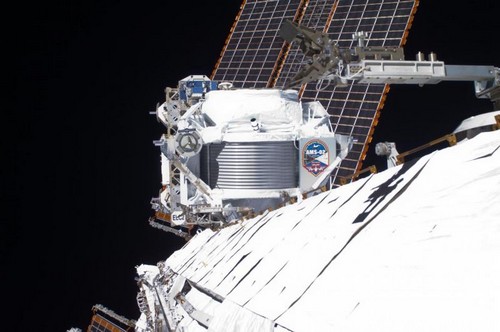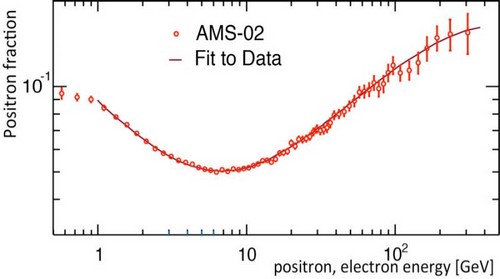First results from the AMS experiment
The Alpha Magnetic Spectrometer (AMS) international collaboration announced the first results of the search for candidate particle of the dark matter April 3. The results, presented by AMS spokesperson Professor Samuel Ting in a seminar at CERN, are to be published in the journal Physical Review Letters. They report the observation of an excess of positrons in the cosmic ray flux.
The AMS experiment, installed on the International Space Station (ISS), is designed to study cosmic ray particles before they have a chance to interact with the Earth’s atmosphere. The AMS results are based on some 25 billion recorded cosmic ray events, including 400,000 positrons with energies between 0.5 GeV and 350 GeV, recorded over a year and a half. This represents the largest data sample of antimatter particles recorded in space. The positron fraction to electron increases from 10 GeV to 250 GeV, with the slope reducing by an order of magnitude over the range 20 -250 GeV. The data also show no significant variation over time, or any preferred incoming direction. The excess of positrons could come from Dark matter, or some astronomy objects in space, such as neutron Stars. AMS will further refine the measurement’s precision, and clarify the behavior of the positron fraction at energies above 350 GeV.
Dark matter is one of the most important mysteries of physics today. Accounting for over a quarter of the universe’s mass-energy balance, it can be observed indirectly through its interaction with visible matter but has yet to be directly detected. Searches for dark matter are carried out in space-borne experiments such as AMS, as well as on the Earth at the Large Hadron Collider and a range of experiments installed in deep underground laboratories.
Chinese scientists have made important contributions to the AMS detector construction and presently to the data analysis. The key component of AMS is the large permanent magnet, which measures the charge of particles. The magnet was designed, constructed and space qualified by the Institute of Electrical Engineering (IEE), the Institute of High Energy Physics (IHEP), and the Chinese Academy of Launch Vehicle Technology (CALT) in Beijing 1995-1997. The magnet was flow by the Space shuttle June 1998 as the first large magnet in Space. After 13 year, the magnet again was installed in the ISS. The electromagnetic calorimeter of AMS is the major sub-detector to measure the energy of electron and positron, as well as to reject the background from protons. The calorimeter with the weight of 700 kg was designed and manufactured by IHEP and CALT, as well as INFN/Pisa and IN2P3/Annacy. The IHEP AMS team also made important contribution to the data analysis and physics studies of the first results.

From its vantage point ~260 miles (~400 km) above the Earth, the Alpha Magnetic Spectrometer (AMS) collects data from primordial cosmic rays that traverse the detector.

The positron fraction measured by AMS demonstrates excellent agreement with the model described below. Even with the high statistics, 6.8 million events, and accuracy of AMS, the fraction shows no fine structure.